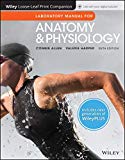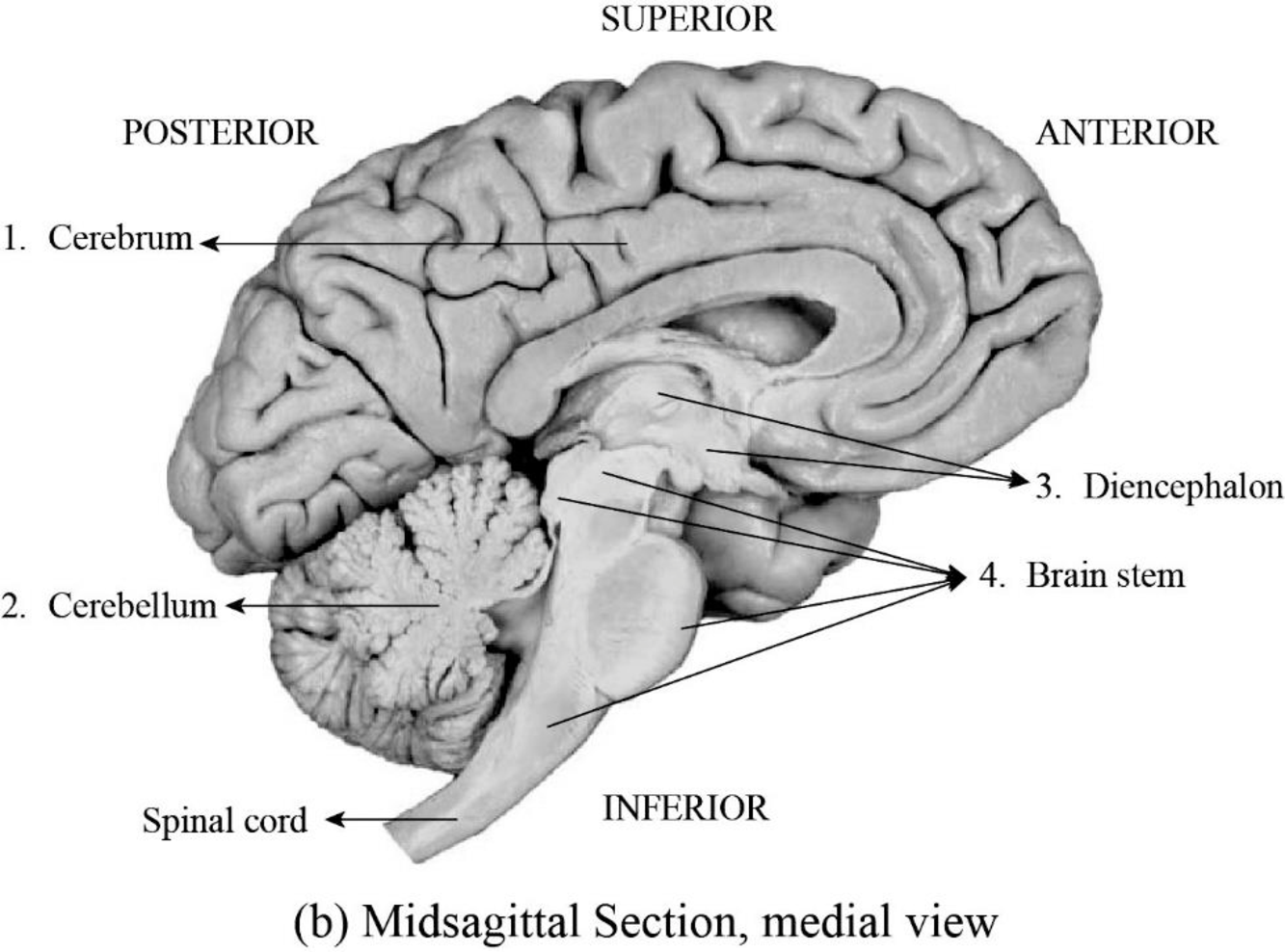
Concept explainers
To identify: The major brain regions in Fig 20.1.
Introduction: The brain is the most vital organ in the human body. The brain has three major regions namely, the cerebrum, brainstem, and cerebellum. The brain is the central processing unit of the body as most of the processes such as, voluntary to involuntary function and the cognitive function, are carried out by the brain.
Answer to Problem 1.1BGL
Pictorial representation:

Fig.1: The major brain regions.
Explanation of Solution
Cerebrum: The cerebrum is the biggest and the most complicated among all the regions and structures of the brain. The cerebrum is divided into the left and right hemispheres. The cerebrum account for higher mental functions, cognitive thinking, and intelligence. The cerebrum accounts for thinking and reasoning to process the information from the surrounding that can implement the desired movement in the skilled skeletal movement.
Cerebellum: The cerebellum is also called as little brain and located inferior to the cerebrum and posterior to the pons and medulla oblongata. The vital functions of the cerebellum are to process sensory information, maintain balance, posture, and aid in the movement of the skeletal muscles in a skillful way. Depending upon the injury in the cerebellum, the person can be paraplegic from the neck to the feet, paraplegic only to the waist, or only below the waist. Some minor injury in the cerebellum can lead to the unsteady gait, loss of coordinated movement, and slurred speech.
Diencephalon: The “di” means two and “encephalon” means the brain, as it is embedded inferior to the two cerebral hemispheres and anterior to the midbrain. Thus, the diencephalon occupies the central region of the brain. The diencephalon contains the thalamus, hypothalamus, and epithalamus, which are important for secreting hormones, process sleep wake cycle, express emotions, and process sensation to eat and drink.
Brain stem: The brain stem has three major regions namely, the pons, midbrain, and medulla oblongata. The brain stem is located posterior to the superior brain region. The brain stem is a vital feature of the brain as it maintains consciousness as well as regulate the sleep cycle. Any injury to the brain stem leads to life-threatening complications.
Want to see more full solutions like this?
Chapter 20 Solutions
Laboratory Manual for Anatomy and Physiology, 6e WileyPLUS (next generation) + Loose-leaf
- , if one of the archaeological specimens lacked the celiac disease-causing epitope, how could PCR be used to identify the allele in a contemporary germplasm collection of wild wheats, and to assist in transferring the allele to modern wheat varieties?arrow_forwardNow you will consider the composition of lipoproteins, including where they are synthesized, how they circulate, and where the various lipid and protein components are located within the lipoprotein molecule. Drag the appropriate labels to their respective targets.arrow_forwardThe Oregon Wolfe Barley mapping population is unique in having 12 easily-scored morphological markers, each showing monogenic inheritance. Do you consider these markers useful? Briefly defend your answer, pointing out advantages and disadvantages of morphological vs. molecular markers.arrow_forward
- Biopharmaceutics and Pharmacokinetics:Two-Compartment Model Instant Absorption Questions Calculate these : a) B1, b) B2, c) hybrid rate constant (1) d) hybrid rate constant (2) e) t1/2,dist f) t1/2,elim g) k10 h) k12 i) k21 j) initial concentration (C0) k) central compartment volume (V1) l) steady-state volume (Vss) m) clearance (CL) AUC (0→10 min) using trapezoidal rule n) AUC (20→30 min) using trapezoidal rule o) AUCtail (AUC360→∞) p) total AUC (using short cut method) q) volume from AUC (VAUC)arrow_forwardIn a population of Jackalopes (pictured below), horn length will vary between 0.5 and 2 feet, with the mean length somewhere around 1.05 feet. You pick Jackalopes that have horn lengths around 1.75 feet to breed as this appears to be the optimal length for battling other Jackalopes for food. After a round of breeding, you measure the offsprings' mean horn length is 1.67. What is the heritability of horns length (h2)? Is Jackalope horn length a heritable trait? (4 pts)? 12pt v R Paragraph V BIU A श्र > Barrow_forwardThere are many differences between DNA replication happening during mitosis in a Douglas fir tree growing in the Oregon Cascade Mountains and DNA replication happening during a PCR reaction in a forestry research lab at Oregon State University where the laboratory is amplifying a Simple Sequence Repeat. Complete the following table that compares the two DNA replication events in terms of the primers, the nucleotides, the polymerase, and the target sequence. Additionally, give a general value for the number of copies of the template DNA after one S phase in one cell and after the lab has completed the PCR reaction. Tree SSR Type your answer here: Primers Nucleotides Polymerase Target sequence Number of copiesarrow_forward
- Describe how insulin binding to its receptor induces glucose uptake in healthy individuals. Please specifyeach step in the cascade and use a diagram to illustrate the answer.arrow_forwardThere is a patient with breast cancer, after staining the breast tissue with H&E, state the molecular subtype of the tumour extracted. Results of H&E staining are down belowarrow_forwardBiopharmaceutics and Pharmacokinetics:Two-Compartment Model Instant Absorption Questions Calculate these : a) B1, b) B2, c) hybrid rate constant (1) d) hybrid rate constant (2) e) t1/2,dist f) t1/2,elim g) k10 h) k12 i) k21 j) initial concentration (C0) k) central compartment volume (V1) l) steady-state volume (Vss) m) clearance (CL) AUC (0→10 min) using trapezoidal rule n) AUC (20→30 min) using trapezoidal rule o) AUCtail (AUC360→∞) p) total AUC (using short cut method) q) volume from AUC (VAUC)arrow_forward
- Use the Henderson-Hasselbalch equation for a propanoic acid solution (CH₂CH₂CO₂H, pK₁ = 4.874) to calculate the quotient [A-]/[HA] at three different pH values. pH = 4.479 [A-] [HA] [A-] pH = 4.874 [HA] = pH = 5.220 [A-] = [HA]arrow_forwardIn order to establish the expiration date of perishable food, growth curve data must be collected. Once the microbial load is so high that it poses a hazard to human health, the food item is no longer considered safe (expired). Generally a load of x50,000 bacteria/gram is considered unsafe. Your task is to determine the microbial growth curves for MicroYo, a new brand of yogurt. The growth is determined by sampling the yogurt and growing the bacterial isolates in broth culture which is then serially diluted by a total of x10,000 and inoculated onto standard petri plates of nutrient agar. The following colony counts are measured: Time (days) MicroYo colony count# 1 1 4 1 12 2 16 20 4 7 What day should you recommend expiring the yogurt (the last possible date before the microbial load is unsafe). 12 4 20 16arrow_forward9. Chicken combs in chickens is an example where you see interactions between genes. See potential genotypes and phenotypes below. Which genotype, when mated to a rose comb chicken, will produce progeny that are 50% walnut comb and 50% pea comb? walnut (RRPP) walnut (RrPP) pea (rrPP) walnut (RRPP) walnut (RrPp) pea (rrPp) rose rose single (RRPP) (Rrpp) (rrpp)arrow_forward
 Human Anatomy & Physiology (11th Edition)BiologyISBN:9780134580999Author:Elaine N. Marieb, Katja N. HoehnPublisher:PEARSON
Human Anatomy & Physiology (11th Edition)BiologyISBN:9780134580999Author:Elaine N. Marieb, Katja N. HoehnPublisher:PEARSON Biology 2eBiologyISBN:9781947172517Author:Matthew Douglas, Jung Choi, Mary Ann ClarkPublisher:OpenStax
Biology 2eBiologyISBN:9781947172517Author:Matthew Douglas, Jung Choi, Mary Ann ClarkPublisher:OpenStax Anatomy & PhysiologyBiologyISBN:9781259398629Author:McKinley, Michael P., O'loughlin, Valerie Dean, Bidle, Theresa StouterPublisher:Mcgraw Hill Education,
Anatomy & PhysiologyBiologyISBN:9781259398629Author:McKinley, Michael P., O'loughlin, Valerie Dean, Bidle, Theresa StouterPublisher:Mcgraw Hill Education, Molecular Biology of the Cell (Sixth Edition)BiologyISBN:9780815344322Author:Bruce Alberts, Alexander D. Johnson, Julian Lewis, David Morgan, Martin Raff, Keith Roberts, Peter WalterPublisher:W. W. Norton & Company
Molecular Biology of the Cell (Sixth Edition)BiologyISBN:9780815344322Author:Bruce Alberts, Alexander D. Johnson, Julian Lewis, David Morgan, Martin Raff, Keith Roberts, Peter WalterPublisher:W. W. Norton & Company Laboratory Manual For Human Anatomy & PhysiologyBiologyISBN:9781260159363Author:Martin, Terry R., Prentice-craver, CynthiaPublisher:McGraw-Hill Publishing Co.
Laboratory Manual For Human Anatomy & PhysiologyBiologyISBN:9781260159363Author:Martin, Terry R., Prentice-craver, CynthiaPublisher:McGraw-Hill Publishing Co. Inquiry Into Life (16th Edition)BiologyISBN:9781260231700Author:Sylvia S. Mader, Michael WindelspechtPublisher:McGraw Hill Education
Inquiry Into Life (16th Edition)BiologyISBN:9781260231700Author:Sylvia S. Mader, Michael WindelspechtPublisher:McGraw Hill Education





